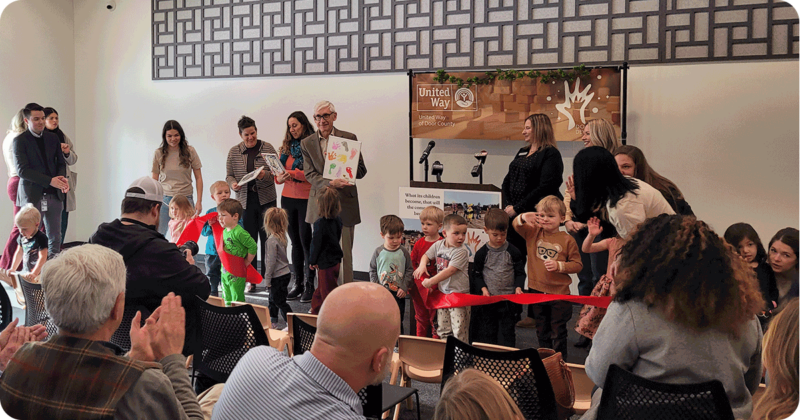
Governor Tony Evers and WEDC Secretary Missy Hughes attended the ribbon cutting ceremony for a new child care center in Door County.
WEDC is supporting efforts by organizations around the state that are solving child care challenges for working parents.
The need for affordable child care goes beyond just ensuring that children are safe and supervised. It’s actually a workforce issue; helping their parents stay employed not only improves the financial situation of individual families, but helps ease labor shortages and contributes to overall economic growth.
This is the driving principle behind WEDC’s investments in child care through Workforce Innovation Grants and other programs.
“For too long, child care has been considered just a family or education issue,” says WEDC Secretary and CEO Missy Hughes. “It’s not. Addressing the challenges in Wisconsin’s child care market is also an economic and workforce issue.”
Child care for an infant in Wisconsin costs between $9,000 and $14,000 a year; households earning less than the federal poverty level with children under age 13 spend about one-third of their income on child care, according to the National Survey of Early Care and Education. At the same time, child care centers aren’t able to charge enough to grow their businesses to meet growing demand or even keep the doors open in too many cases. And according to the Wisconsin Department of Children and Families (DCF), the average early childhood teacher in our state is paid $12.99 an hour—making it difficult to recruit for child care jobs and retain those employees.
These competing pressures have led to a decline in the number of available child care spots. DCF estimates that there was a 30% drop in licensed child care facilities from 2018 to 2022, with smaller providers hit the hardest; additional research tells us that those businesses closing has a greater impact on low-income families, families with infants, rural families, people of color, and workers who work outside the traditional 9-to-5 workday. Geographically, the number of child care spots available declined in Northern and Northeastern Wisconsin and in rural areas.
With estimates showing the scarcity of child care is costing Wisconsin’s economy between $4.2 billion and $6.4 billion over a 10-year period—factoring in lost wages, lost tax revenue, and lost productivity for businesses—WEDC has recognized this as a critical issue affecting the state’s economic growth and made child care a key focus in the Workforce Innovation Grant Program, launched in 2021 in partnership with the Wisconsin Department of Workforce Development.
In one of the grant projects focusing on child care, Door County United Way and their partners will receive up to $3.5 million to increase the number of child care spots at the county’s two nonprofit child care centers, including construction of the new Doorway to Learning in Sturgeon Bay and remodeling the Northern Door Children’s Center in Sister Bay. Prior to these facility upgrades, Door County Medical Center (one of the project partners) stepped up to pay rent for the nonprofit Door Community Child Development Center (the former name of Doorway to Learning) and to cover the building’s maintenance needs; recognizing the impossibility of staffing their medical facility without access to child care for employees, they took action to keep the doors open on what was then Sturgeon Bay’s only licensed group child care facility. The grant project also includes an element that will address workforce housing needs: The Door County Housing Partnership is using a community land trust model to ensure affordability for subsequent buyers and ensure affordable home ownership for area workers, including at least two early childhood educators at the nearby Northern Door Children’s Center.
In Green County, WEDC is partnering with the Green County YMCA to expand its child care operations. The Green County YMCA is using a Workforce Innovation Grant of up to $3.7 million to expand its building and increase the number of child care openings available to area families as well as provide after-school opportunities for school-age kids. A major employer in that area, Colony Brands, is also contributing support in recognition of the importance of child care to their employees.

Rendering of new child care facility at the Goodman campus
Meanwhile, Madison College and its partners were awarded a Workforce Innovation Grant of up to $2.9 million to help increase access to training for child care workers in South Central Wisconsin and to assess the child care needs of Madison College students. Without child care, parents cannot further their education; the new early childhood center created through this project, scheduled to break ground this month, will double as a training site for early childhood educators.
Under another WEDC program, Community Development Investment Grants will support the renovation of a former elementary school in Richland County into an intergenerational day care center for children and older adults and the transformation of an old armory building in Platteville into a community center offering services including child care.
Both projects will increase the number of available child care slots in communities that desperately need them. WEDC has also added a 15% business tax credit for capital expenditures when companies invest in establishing child care programs for employees, thus providing a further incentive for businesses to contribute to solving this challenge.
“We believe these initiatives are a solid start, but to solve this issue in the long term, we are going to need to continue to innovate,” says Hughes. “We are gratified to see how productively government, business, and nonprofit leaders are working together toward this shared goal. If Wisconsin is going to live up to its potential, we need everyone at the table, bringing solutions and ideas for building better communities where everyone can thrive.”
